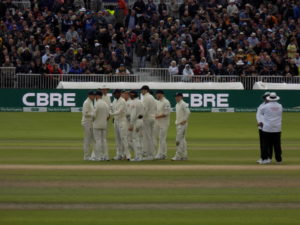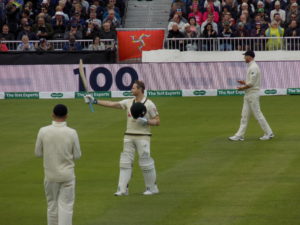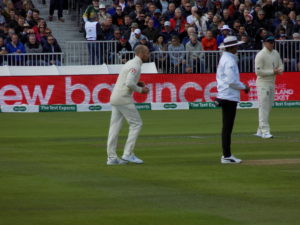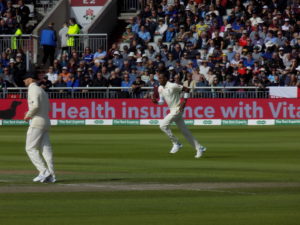Ad Astra
27 September 2019
Beware: spoilers
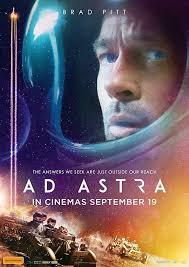 Ad Astra is not a commercial for a motor car made by Vauxhall, but a movie which Georgina took me to see this week. The title is a Latin phrase meaning To the Stars, which as we shall see is somewhat inappropriate in this case. The film was released earlier this year; it is directed by James Gray and stars Brad Pitt, who is also listed among the producers. There are several notable co-stars including Tommy Lee Jones and Donald Sutherland (both now, alas, showing their years), plus Liv Tyler who scarcely gets to speak. But their roles are subordinate to Pitt: he alone carries the story.
Ad Astra is not a commercial for a motor car made by Vauxhall, but a movie which Georgina took me to see this week. The title is a Latin phrase meaning To the Stars, which as we shall see is somewhat inappropriate in this case. The film was released earlier this year; it is directed by James Gray and stars Brad Pitt, who is also listed among the producers. There are several notable co-stars including Tommy Lee Jones and Donald Sutherland (both now, alas, showing their years), plus Liv Tyler who scarcely gets to speak. But their roles are subordinate to Pitt: he alone carries the story.
I think I had better attempt a brief summary of the plot, otherwise the rest of this won’t make much sense. The setting is the mid-future, fifty or so years from now. There are human settlements on the moon and Mars, and the further reaches of the solar system (but not the stars!) are starting to be explored. Pitt plays Major Roy McBride, an astronaut, whose father Clifford McBride (Tommy Lee Jones) led an expedition out to Neptune which ended in failure and presumed death of the crew.
Now unexplained, potentially catastrophic, power surges are occurring throughout the solar system which appear to emanate from Neptune, and which it is believed McBride senior may in some manner have instigated. Roy McBride is sent to investigate., with the ageing Colonel Pruitt (Sutherland) as his mentor.
The film has been billed as a science fiction adventure story, but really that is misleading. The SF elements are necessary background, and there are adventurous moments, but the core of this film is the relationship between son and father. James Gray admits to being influenced by Coppola’s Apocalypse Now (a film which, I should say, I disliked when I saw it many years ago, and have not revisited); and Coppola was in turn strongly influenced by Joseph Conrad’s Heart of Darkness, a book which I have never read. So my account of the relationship between movies and book is, at best, third hand. Nonetheless, Ad Astra does seem to me to be well described as a journey to the heart of darkness, here with an Oedipal twist: Roy McBride is resentful of his father, and has clearly been psychologically damaged by him or, rather, by his absence. Whether he actually wants to kill him… well, it’s a moot point.
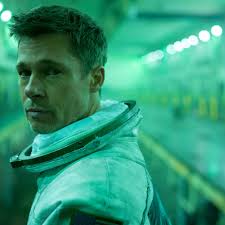 The mood of the film is set by Pitt’s performance, upright (perhaps that should be uptight) and inscrutable. This is a character who never panics and is never ruled by his feelings. I wonder whether casting the gorgeous Liv Tyler in a decidedly unglamorous role as his wife, whom he neglect in his pursuit of the mission, is deliberate; he really is giving everything up.
The mood of the film is set by Pitt’s performance, upright (perhaps that should be uptight) and inscrutable. This is a character who never panics and is never ruled by his feelings. I wonder whether casting the gorgeous Liv Tyler in a decidedly unglamorous role as his wife, whom he neglect in his pursuit of the mission, is deliberate; he really is giving everything up.
But there is unease beneath the façade. From time to time, McBride reports directly to an AI which assesses and reports instantly on his psychological fitness for duty. I was not totally convinced by the competence of this AI; perhaps I was not meant to be, and perhaps McBride too is going through the motions of an exercise he deems pointless. One of the film’s many constructive ambiguities. There are also numerous voiceovers, which I think are meant to represent McBride’s own inner voice. They are undeniably effective in setting mood and establishing character, but voiceover is a tricky device and I thought it was overused here, like a second-rate novelist who writes his characters’ thoughts in italics rather than letting them be inferred from their words and actions.
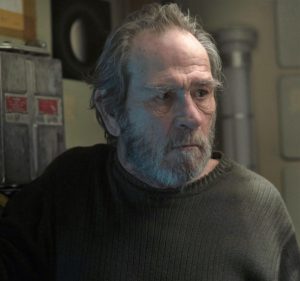 McBride starts his voyage to his father with several companions, but by the time he arrives at Neptune he is on his own. The climactic encounter – for father and son do eventually meet, as we all foresee they must – is curiously underwhelming. Tommy Lee Jones used to have a volcanic on-screen presence, and maybe he still does when called upon, but here it is dialled right down. I won’t reveal the ending, but although it is implied that for McBride junior the meeting is cathartic, it’s all very low-key. At the end there is some dramatic action – almost melodramatic – but I really felt this strand of the story required a more powerful, personal confrontation.
McBride starts his voyage to his father with several companions, but by the time he arrives at Neptune he is on his own. The climactic encounter – for father and son do eventually meet, as we all foresee they must – is curiously underwhelming. Tommy Lee Jones used to have a volcanic on-screen presence, and maybe he still does when called upon, but here it is dialled right down. I won’t reveal the ending, but although it is implied that for McBride junior the meeting is cathartic, it’s all very low-key. At the end there is some dramatic action – almost melodramatic – but I really felt this strand of the story required a more powerful, personal confrontation.
McBride senior’s original mission had been to search for life beyond the solar system, but he has so far found none. We are truly alone. Gray clearly intends this as a context for the film’s earlier scenes, of human conflict over resources on Moon, Mars and in the asteroid belt, which we might otherwise have thought were merely scene-setting. If we are kind, we might see this as showing his ambition as a film-maker to create something meaningful. I do think that a good SF film could be made with We Are Truly Alone as its major theme. But Ad Astra isn’t it; its focus is elsewhere.
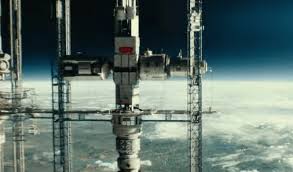 The film’s opening sequence sets the bar very high. Roy McBride is working on an antenna (cleverly designed to look like several vertical ladders, joined together by a control-room structure) high in the stratosphere: repair teams require space suits but gravity still grips. A power surge strikes the antenna and McBride literally falls to earth (don’t worry, he has a parachute). This sequence is truly spectacular. But it sets a false tone: the rest of the film is not a thriller and barely an adventure, and nothing else in it is so edge-of-your-seat compelling.
The film’s opening sequence sets the bar very high. Roy McBride is working on an antenna (cleverly designed to look like several vertical ladders, joined together by a control-room structure) high in the stratosphere: repair teams require space suits but gravity still grips. A power surge strikes the antenna and McBride literally falls to earth (don’t worry, he has a parachute). This sequence is truly spectacular. But it sets a false tone: the rest of the film is not a thriller and barely an adventure, and nothing else in it is so edge-of-your-seat compelling.
 However, the sequences in space are well designed (albeit in line with modern SF conventions of what spacecraft and space stations should look like) and flawlessly executed. The graphics artists clearly had a field day: awards will no doubt follow. Spacecraft interiors are appropriately antiseptic and cluttered; bases are dull places, vacant or confined. The overall design contributes to the claustrophobic paranoia of the plot.
However, the sequences in space are well designed (albeit in line with modern SF conventions of what spacecraft and space stations should look like) and flawlessly executed. The graphics artists clearly had a field day: awards will no doubt follow. Spacecraft interiors are appropriately antiseptic and cluttered; bases are dull places, vacant or confined. The overall design contributes to the claustrophobic paranoia of the plot.
 I’m afraid, though, that this attention to design is not followed through in the science, which is next to non-existent. Here are some instances; I’m sure there are more.
I’m afraid, though, that this attention to design is not followed through in the science, which is next to non-existent. Here are some instances; I’m sure there are more.
- Gravity on the Moon and Mars is one-sixth and one-third, respectively, of Earth’s. This is disregarded: these locations are shown having Earth-normal gravity.
- Radio messages travel at the speed of light. It takes eight minutes for the Sun’s light to reach us, and Neptune is thirty times more distant (with the Sun in the way for half of that time). This also is disregarded: communications between Earth and Mars, and later between Mars and Neptune, appear to be made, or replies to be expected, instantly.
- Optimum transit time between Earth and Mars using conventional chemical rockets, as depicted in the film, is measured in months. Between Mars and Neptune would take years. This is disregarded and McBride’s flights go about twenty times faster. Georgina excuses this: in fifty years’ time (she says) propulsion technology should have improved. But not to this extent, and not with chemical rockets.
- And because of momentum and inertia the whole sequence involving McBride’s spacecraft responding to a Mayday call is preposterous in any event.
- The final sequence (I won’t be more specific, to preserve at least a small surprise) is ingenious but barely feasible, and ignores inevitable gross damage to craft and pilot.
- The idea that power surges occurring in Neptune orbit would somehow have catastrophic effects on Earth is insanely improbable. But it’s an obvious McGuffin which sets the story going but is then forgotten, so perhaps this error, on its own, would be forgivable.
None of this would matter if Ad Astra was a Star Wars or Marvel superhero type of film, in which all kinds of impossibilities are accepted for the sake of the story. But Gray and Pitt are clearly trying to do something more than that, and this failure to reflect scientific realism taints all their efforts.
I don’t want to end on such a negative note. Georgina enjoyed the film very much (not only, I think, because Brad Pitt is in it – though he is undeniably a handsome blighter). I admired the performances, the cinematography and the sheer ambitio, and the story is compelling if not exactly original. But next time they make a serious science fiction movie they need to get an actual scientist on board.
——————–
Chihuly
26 September 2019
Dale Chihuly is an American artist who creates large scale installations and environmental artwork out of glass. I hesitate to call him a sculptor, as glass is not readily shaped with the sculptor’s traditional tools of hammer and chisel. But the works which he produces are, to all intents and purposes, abstract sculptures which happen to be made out of glass.
An exhibition of Chihuly’s work is currently on display at Kew Gardens in London. It’s not the first time that Chihuly has had a show at Kew. John and I still remember the previous exhibition which according to Wiki was in 2005; I can scarcely believe it was so long ago. But at any rate we were enraptured, and very keen to go again. John provided all the photos which go with this blog so my thanks, once again, to him.
Chihuly’s principal method is glass blowing, which enables a wide variety of shapes, patterns and colours to be produced. But for this latest exhibition I think he must also be making some use of moulds, as I don’t see how blowing alone could produce the straight edges, angles or corners that appear in a couple of the exhibits.
Following a couple of accidents, Chihuly is no longer a hands-on artist: he hires others to produce the works according to his direction. He sees his role as “more choreographer than dancer… more director than actor.” I suppose this is fair enough, in the tradition of other great artists; and the vision to produce these pieces is remarkable in any case.
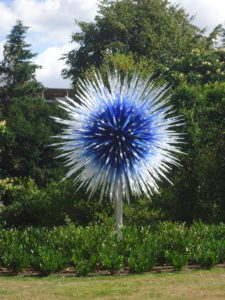 I won’t write too much more, but will leave John’s photos to speak for themselves. Above is the first exhibit, titled Sapphire Star, which can be seen on the left when you go through the main gate at Kew. It’s a good illustration of the effects Chihuly can achieve and I think it may be my favourite from the whole exhibition.
I won’t write too much more, but will leave John’s photos to speak for themselves. Above is the first exhibit, titled Sapphire Star, which can be seen on the left when you go through the main gate at Kew. It’s a good illustration of the effects Chihuly can achieve and I think it may be my favourite from the whole exhibition.
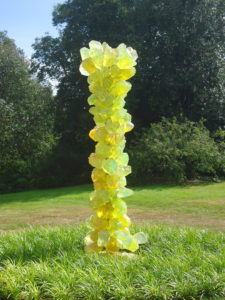 Here’s the next, Lime Crystal Tower. This is a rather atypical Chihuly and you may be able to see the edges and corners which make me think this object involved something else besides freehand glass blowing.
Here’s the next, Lime Crystal Tower. This is a rather atypical Chihuly and you may be able to see the edges and corners which make me think this object involved something else besides freehand glass blowing.
 Now these, the Niijima Floats, are by Chihuly’s standards relatively ordinary. Marbles, anyone?
Now these, the Niijima Floats, are by Chihuly’s standards relatively ordinary. Marbles, anyone?
 In Kew’s Temperate House (a massive glasshouse, for those not familiar with Kew) there are several Chihuly pieces, artfully crafted to fit in with the botanical exhibits. This is the centrepiece, suspended from the roof.
In Kew’s Temperate House (a massive glasshouse, for those not familiar with Kew) there are several Chihuly pieces, artfully crafted to fit in with the botanical exhibits. This is the centrepiece, suspended from the roof.
 But John and I thought these Fiori Verdi even more striking, though again I don’t see how Chihuly could achieve the radial ribbing effects without some kind of mould. One of the qualities of Chihuly’s work is how comfortably it sits alongside the plants. I think it’s something to do with the curves.
But John and I thought these Fiori Verdi even more striking, though again I don’t see how Chihuly could achieve the radial ribbing effects without some kind of mould. One of the qualities of Chihuly’s work is how comfortably it sits alongside the plants. I think it’s something to do with the curves.


 And here are some other Temperate House pieces. See how they fit in with the plants alongside.
And here are some other Temperate House pieces. See how they fit in with the plants alongside.
 These rather grotesque bulbous pieces are called Ikebanas and in each case they consist of a pot and a separate twisty thin glass tube. We’ll see this idea again later.
These rather grotesque bulbous pieces are called Ikebanas and in each case they consist of a pot and a separate twisty thin glass tube. We’ll see this idea again later.
 A recurring theme in Chihuly’s outdoor exhibits is a reed shape and here are some more, in the gardens outside the Temperate House.
A recurring theme in Chihuly’s outdoor exhibits is a reed shape and here are some more, in the gardens outside the Temperate House.
 I particularly like this one, Neodymium Reeds and Turquoise Marlins, for its contrast of colours and shapes. Neodymium, by the way, is an element, one of the rare earths in the lanthanide series. I bet you didn’t know that.
I particularly like this one, Neodymium Reeds and Turquoise Marlins, for its contrast of colours and shapes. Neodymium, by the way, is an element, one of the rare earths in the lanthanide series. I bet you didn’t know that.
 My favourite place to visit in all of Kew Gardens is the Waterlily House which is hot and humid enough for a slice of jungle. Very often the waterlily pond has leaves floating on the surface large and firm enough to support the weight of a dog or a small child (not that I recommend trying this out), but Chihuly has provided a new centrepiece. You can see some of the real waterlily flowers in this photo too; the Chihuly complements them well.
My favourite place to visit in all of Kew Gardens is the Waterlily House which is hot and humid enough for a slice of jungle. Very often the waterlily pond has leaves floating on the surface large and firm enough to support the weight of a dog or a small child (not that I recommend trying this out), but Chihuly has provided a new centrepiece. You can see some of the real waterlily flowers in this photo too; the Chihuly complements them well.
 Apparently this Scarlet and Yellow Icicle Tower has 1,882 separate elements.
Apparently this Scarlet and Yellow Icicle Tower has 1,882 separate elements.
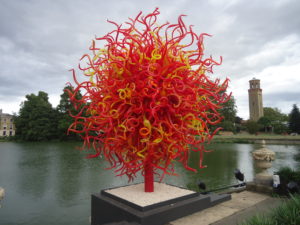 And another gorgeous large scale outdoor piece to finish. This one is called Summer Sun. Just fitting it all together must have been a bit of a nightmare for someone.
And another gorgeous large scale outdoor piece to finish. This one is called Summer Sun. Just fitting it all together must have been a bit of a nightmare for someone.
Chihuly doesn’t only produce large scale glass installations. In the Shirley Sherwood Gallery of Botanical Art is a collection of his smaller pieces, several of which are truly exquisite. Here too are some more Ikebanas, with some extra-special grotesque effects.


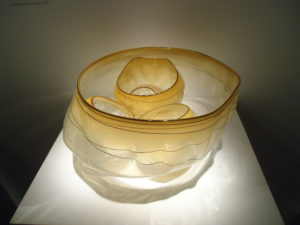

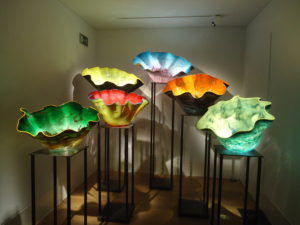

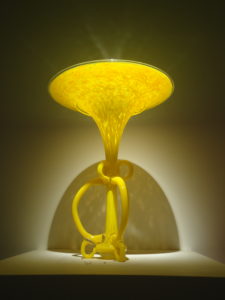
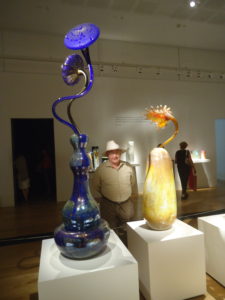 The Gallery also has a shop with Chihuly pieces (that is, from his workshop) on sale. Starting at about £1,000. If anyone out there feels like giving me a really generous Christmas present…
The Gallery also has a shop with Chihuly pieces (that is, from his workshop) on sale. Starting at about £1,000. If anyone out there feels like giving me a really generous Christmas present…
——————–
Two days of England vs Australia
6 September 2019
John and I have just spent two days at the England vs Australia Test match at Old Trafford, the fourth in a series which is currently tied 1-1, with one draw. It was our first visit since the South Africa Test two years ago, about which I also blogged (6 August 2017). There was no Test at Old Trafford last year. The photos here are by John – thanks to him as always.
I am never really bored or unhappy when watching cricket, but we had rather an uncomfortable time. This was partly due to the weather. The cricket authorities, in their eagerness to accommodate both the World Cup and the Ashes into a single English summer, have allowed the Test series to spill over well into September: the final Test, at the Oval, will not begin until next Thursday, 12th September, which is later than ever before.
 On Wednesday morning it was merely chill and overcast, but at lunchtime the cloud thickened and we had heavy enough rain to delay the resumption of play for two and a half hours. After tea we had another hour or so before the players were finally forced from the field by a mixture of rain and bad light. There was also a chill wind blowing in gusts strong enough to dislodge the bails (for a while play continued without them, until heavier replacement bails were secured) which clearly discommoded the players. As for the poor spectators, despite our large green umbrella we were soaked and chilled. John and I had both made the mistake of wearing only one pullover and a thin coat each, and before we went home (about 5.30 pm) we were shivering.
On Wednesday morning it was merely chill and overcast, but at lunchtime the cloud thickened and we had heavy enough rain to delay the resumption of play for two and a half hours. After tea we had another hour or so before the players were finally forced from the field by a mixture of rain and bad light. There was also a chill wind blowing in gusts strong enough to dislodge the bails (for a while play continued without them, until heavier replacement bails were secured) which clearly discommoded the players. As for the poor spectators, despite our large green umbrella we were soaked and chilled. John and I had both made the mistake of wearing only one pullover and a thin coat each, and before we went home (about 5.30 pm) we were shivering.
On the second day we were better prepared, with an extra pullover each. The wind was lighter and less gusty, and after a delay for light rain in the morning play continued until about 7.15 pm, by which time the sun was setting behind the stands on the far side of the ground. Ten years ago, play would have been abandoned much earlier because of the bad light, but now there are floodlights. Even so, I thought it was pretty dark by the end and was surprised the umpires did not call a halt earlier.
Our discomfort was increased by England’s performance, which frankly I thought was a bit shabby. It started with the selection of Craig Overton ahead of either Chris Woakes or Sam Curran, both of whom were in the squad and available. This was apparently on the basis that a bowler whose main weapon is lift would be more effective than one whose main weapon is swing. It’s true that Old Trafford has a reputation for offering more bounce to quick bowlers than other test grounds in England. But conditions also play a part. From the weather forecasts it must have been clear that much of the match would be played in overcast conditions, which generally favour swing bowling. And Australian batsmen have always been more comfortable against bounce, which they encounter regularly on their home pitches, than against swing which they do not.
In addition, Sam Curran had a successful series last year in England against India and appears to be one of those players who make things happen by a mixture of cricketing instinct and force of character. If Woakes was to be dropped for whatever reason (it may be that he is simply exhausted after the World Cup – undeniably he has not been at his best) Curran was the obvious replacement. Overton was a left-field selection predicted by no-one, a hunch with a bogus rationale.
In the event, Overton did not disgrace himself. He delivered a sharp inswinger to bowl Marnus Labuschagne, and with the first ball after tea on Thursday he found a leg-cutter which induced Tim Paine to give a catch to slip. Both batsmen were well-set and, I dare say, surprised, as Overton’s bowling had otherwise been nondescript. But neither he nor any other England bowler had an answer to the stellar performance of Australia’s Steve Smith, who over the two days compiled an innings of 211.
Smith is an extraordinary batsman with a technique all his own. He moves to face square on to straight deliveries which he is then able to hit away on the leg side, but readjusts to play orthodox shots to deliveries outside his off stump. He looks like a candidate to be bowled or lbw if he misses a straight ball, but somehow he never does. He is as vulnerable as anyone else if a bowler gets a ball on the off stump to move away late, but with Anderson injured, and without Curran or Woakes, England had no-one capable of doing this.
It wasn’t quite a faultless innings. Early on Thursday morning, when Smith was 65, he gave a hard return catch to Archer which was dropped, and at 119 he was caught at slip off Jack Leach from a delivery which video showed to be a no-ball. This incident in particular seemed to unsettle the England fielders. Although Vic Marks in his report in the Guardian offers a technical explanation of how Leach came to make this error, the fact is that no spin bowler should ever overstep the line; it is an easily avoidable mistake. Otherwise Leach’s bowling was perhaps England’s best, or at least most consistent (Broad was good at the start of the match but cooled off later), but this error will haunt him for the rest of his career.
But England’s performance in the field was lacklustre all round. Archer bowled poorly and far too short. Stokes was expensive and unthreatening. Roy dropped a straightforward slip catch given by Paine when he was 9: that would have nipped in the bud a partnership with Smith that went on to add 145. The ground fielding was never quite ragged, but neither was it taut. Two aspects I think worthy of particular criticism: Bairstow’s wicket-keeping and Root’s captaincy.
It’s not that Bairstow is especially untidy. He drops the ball more than a top-class wicket-keeper would do but he didn’t miss anything significant, and some of his takes off Archer’s wilder bouncers were quite spectacular. But he stood too far back to the quick bowlers (except Archer), especially when they were bowling into the wind, and was frequently receiving the ball down by his ankles. Since it is the keeper whose position also determines that of the slip fielders, Bairstow must take some blame for two possible catches which dropped just in front of where the slips were standing.
I also think he is a bit lazy. As soon as the ball strays down the leg-side a good wicket-keeper should be moving in anticipation. Bairstow is slow to do so, which he only partly compensates for with his athletic leg-side takes. And he is very slow getting up to the stumps after the batsman has hit the ball. The keeper should be at the stumps as quickly as possible, ready to take a return from the field. Bairstow gets there eventually, but he’s slow and doesn’t always bother.
As for Root, I thought he was unimaginative in how he used his bowlers. He gave Archer too long at the start of the innings so he wasn’t ready to take over when Broad, who had been bowling with the wind, was rested. He failed to control Archer whose persistent short bowling was ineffective and wasteful. He brought Stokes on to bowl before Overton, which didn’t look like much of a vote of confidence in the new man. He didn’t bowl himself until the last half hour of Australia’s innings, though the variety would have been useful much earlier.
And some of his field placings were really odd. It was quite difficult at times to see whether he was attacking or defending, with the result that he was doing neither. Particularly during the two main Australian partnerships, between Labuschagne and Smith and then between Smith and Paine, fields were set which allowed easy singles to the leg side despite the batsmen’s (Smith’s especially) predilection for pushing the ball gently to leg. I lost count of how many runs were conceded this way. On the other hand, he persisted with mid-off for the quicker bowlers although until the very end of his innings Smith rarely if ever played the ball that way. There were also some deeply eccentric settings: posting a short mid-off and a short cover for Smith seemed particularly bizarre. By the end of the innings Root seemed to have lost control of proceedings altogether and was simply waiting for Paine to declare.
Granted that Smith is a phenomenon, a challenge for any opposing attack, and that the conditions especially on Wednesday were difficult (but the same for both sides), I still thought this an erratic England performance, lacking in purpose and direction for long stretches, conceding initiative too easily, and waiting for something to happen rather than making it happen. Cricket is a game which demands intelligence as well as skill and athleticism. There wasn’t much intelligence on display here.


